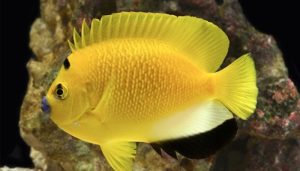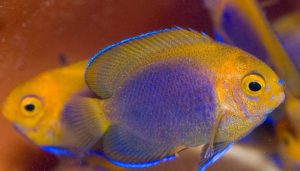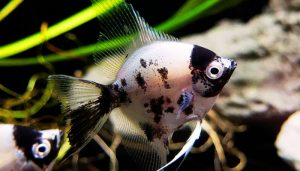What are the Common Angelfish Diseases? Angelfish are a popular choice for both novice and experienced aquarists due to their vibrant colors and graceful appearance. However, like all fish, they are susceptible to various diseases that can jeopardize their health and well-being. Understanding the common ailments that afflict angelfish is essential for any fish keeper, as early detection and treatment can make a significant difference in recovery.
This guide will cover five major diseases: Ich, Fin Rot, Dropsy, Hole-in-the-Head, gill flukes, and Velvet. Each illness has specific symptoms and requires prompt diagnosis and treatment. Quick remedies like salt baths, antibiotics, and water quality adjustments can save your fish.
But these are just the basics! Renowned aquarists like Dr. Gerald Bassleer emphasize early diagnosis for successful treatment. Let’s dive deeper into these diseases and their cures to keep your angelfish and other aquatic animals healthy and thriving.
Table of Contents
ToggleWhat Are the Most Common Angelfish Diseases?
Angelfish can suffer from several common diseases, each caused by different pathogens or environmental factors. One of the most prevalent is ich, also known as white spot disease, which appears as small white cysts on the fish’s skin and fins.
Another common illness is fin rot, which manifests as frayed or disintegrating fins, often due to poor water quality or bacterial infections. Moreover, angelfish may experience velvet disease, characterized by a velvety appearance on the skin, caused by a parasitic infection.

Other diseases include swim bladder disorder, affecting buoyancy, and dropsy, which causes swelling due to fluid retention. Identifying these diseases early is key to effective treatment and recovery.
Angel fish diseases can often be attributed to stressors in their environment, such as overcrowding, fluctuating water temperatures, or poor water quality.
For instance, ich can quickly spread in tanks with high-stress levels or inadequate filtration. Similarly, fin rot is frequently exacerbated in tanks where ammonia levels are high, leading to weakened immune systems.
It’s essential to maintain a stable and clean aquarium environment to prevent your Angel fish getting sick. By understanding the various ailments that can affect angelfish, aquarists can take proactive steps to ensure their fish remain healthy and vibrant, minimizing the risk of disease outbreaks.
How Can You Diagnose Angelfish Diseases?
Diagnosing angelfish diseases involves careful observation of the fish and their environment. Start by examining the fish for visible signs such as discoloration, lesions, or unusual swimming patterns.
For example, if an angelfish is scratching against objects in the tank, it may indicate the presence of parasites like ich or velvet disease. Monitoring water parameters such as pH, ammonia, nitrite, and nitrate levels is crucial, as poor water quality can lead to stress and illness.
Additionally, behavioral changes, such as reduced appetite or lethargy, can be indicative of illness. Keeping a detailed log of these observations can help in identifying patterns and potential issues before they escalate.
In some cases, diagnosing angelfish diseases may require additional testing, especially when symptoms are not easily recognizable. Aquarists can perform a gill scrape or fin biopsy to check for viral infections under a microscope.
Consulting with an experienced aquarist or veterinarian can also provide valuable insights into complex cases. Early diagnosis is vital for effective treatment, as some angelfish sickness can progress rapidly if not addressed promptly.
By being vigilant and observant, fish owners can ensure their angelfish receive the proper care they need and minimize the impact of any potential diseases.
The 5 Common Angelfish Diseases
Here are five common diseases affecting angelfish and how to cure them quickly.
1. Ich (White Spot Disease)
Symptoms: White spots on fins and body, scratching against objects, rapid breathing. Cause: A parasite called Ichthyophthirius multifiliis. Cure:
- Increase water temperature to 82–86°F to speed up the parasite’s life cycle.
- Use an Ich treatment containing malachite green or formalin.
- Perform frequent water changes and vacuum the substrate to remove cysts.
2. Fin Rot
Symptoms: Frayed or discolored fins, sluggish movement, inflamed fin edges. Cause: Bacterial infection due to poor water conditions or injury. Cure:
- Improve water quality by performing regular water changes.
- Treat with antibacterial medications like erythromycin or aquarium salt.
- Remove aggressive tank mates that may be nipping at fins.
3. Dropsy
Symptoms: Swollen belly, raised scales, lethargy, difficulty swimming. Cause: Bacterial infection leading to fluid retention. Cure:
- Isolate the affected fish in a hospital tank.
- Use antibiotics such as kanamycin or tetracycline.
- Maintain pristine water conditions and feed high-quality food such as brine shrimp.
4. Hole-in-the-Head Disease (Hexamita)
Symptoms: Pitting or holes around the head, weight loss, loss of appetite. Cause: Parasitic infection often linked to poor nutrition and water quality. Cure:
- Improve diet by adding vitamin-rich foods and supplements.
- Use metronidazole medication in food or water.
- Keep water conditions optimal and perform frequent water changes.
5. Velvet Disease
Symptoms: Gold or rust-colored dust on the body, clamped fins, rapid gill movement. Cause: A parasite called Piscinoodinium. Cure:
- Dim aquarium lights to slow parasite growth.
- Treat with copper-based medications.
- Raise water temperature slightly to speed up recovery.
Prevention Tips
- Maintain clean water with regular water changes.
- Quarantine new fish before adding them to the tank.
- Provide a balanced diet to strengthen immunity.
- Avoid overcrowding and stress factors in the aquarium.
By recognizing symptoms early and taking swift action, you can effectively treat these common angelfish diseases and keep your fish healthy and thriving.
What Are the Best Treatment Options for Angelfish Diseases?
Treatment options for angel fish diseases vary depending on the specific illness being addressed. For ich, raising the water temperature and adding medicated treatments designed to kill the parasite are effective strategies.
It’s crucial to ensure that all tank inhabitants are treated simultaneously to prevent angelfish virus infection. In the case of fin rot, improving water quality through regular water changes and adding antibacterial medications can promote healing and recovery.
Velvet disease often requires the application of copper medications, but caution is necessary as these can be harmful to invertebrates in the aquarium. For swim bladder disorder, dietary adjustments, such as fasting or feeding high-quality, low-fat foods, can help restore normal function.
Dropsy treatment is more complex, often requiring antibiotics or anti-parasitic medications depending on the underlying cause. Quarantine of the affected fish is essential to prevent the spread of disease to healthy tank mates.
Additionally, maintaining optimal tank conditions is vital for successful treatment, including stable water parameters and a stress-free environment. Regular monitoring and prompt action can significantly improve outcomes for angelfish suffering from these diseases.
Ultimately, a combination of appropriate medication, environmental management, and preventive care will ensure the best chance of recovery and long-term health for angelfish.
How Can You Prevent Angelfish Diseases?
Preventing angelfish diseases is paramount for maintaining a healthy aquarium environment. The first step in prevention is to ensure water quality is consistently monitored and maintained.
Regular water changes, proper filtration, and testing for ammonia, nitrite, and nitrate levels are essential practices. Additionally, avoiding overcrowding in the tank helps reduce stress among the fish, making them less susceptible to angelfish illnesses.
Quarantining new fish before introducing them to the main tank is another crucial measure, as it helps isolate potential pathogens and prevent them from spreading to healthy fish.
Furthermore, maintaining a balanced diet for your angelfish is vital for their overall health and immune system strength. High-quality fish food that is suitable for their dietary needs should be provided, along with occasional treats like frozen or live foods to enhance their nutrition.
Regular observation of fish behavior and physical condition can also help identify early signs of stress or illness, allowing for swift intervention. By implementing these preventive measures, aquarists can significantly reduce the risk of diseases affecting their angelfish and keep their aquarium thriving.
What Should You Do If Your Angelfish Gets Sick?
If your angelfish shows signs of illness, swift action is crucial for their recovery. Begin by isolating the affected fish in a separate quarantine tank to prevent the spread of disease.
Assess the water quality in both the main tank and the quarantine tank, making necessary adjustments to ensure optimal conditions. Identifying the specific illness based on symptoms can guide the treatment approach.
Research appropriate medications and treatments based on the diagnosed disease and administer them as directed. Regular monitoring of the sick fish is essential to evaluate their response to treatment and make any necessary adjustments.
In addition to medication, consider implementing stress-reducing measures in the quarantine tank, such as providing hiding spots and gentle filtration. Maintaining a calm environment can significantly aid in the fish’s recovery process.
If the fish does not show improvement after a few days of treatment, consulting a veterinarian or an experienced aquarist may provide further insight into more advanced treatment options.
Prompt and effective actions taken during the early stages of illness can greatly increase the chances of recovery for your angelfish, ensuring they return to good health and vitality.
Conclusion
Understanding and addressing angelfish diseases is critical for any aquarist seeking to maintain a healthy aquarium. By being aware of the most common diseases, recognizing symptoms, and implementing effective treatment and prevention strategies, fish owners can ensure the well-being of their beloved angelfish. Regular monitoring, optimal water quality, and a balanced diet play significant roles in disease prevention. In the event of illness, taking swift and informed action can make all the difference in the recovery process. Ultimately, with a proactive approach to care and management, angelfish can thrive in a vibrant and healthy aquatic environment.
Recommended posts
- Angelfish Swimming Sideways? Signs, Causes, and How to Help!
- What Do Angelfish Eat? The Best Angelfish Food Choices
- Best Angel fish Water Parameters for a Healthy Aquarium Setup
- The Average Lifespan of Angelfish & How to Improve It
- Freshwater Black Angelfish: Habitat, Lifespan & Tank Mates
- Angel fish pH Level: Best Water Conditions for Healthy Fish
- Angel fish Fin Rot Treatment: Step-by-Step Recovery Guide
- Angelfish Hole in the Head Disease (Causes & Best Treatment)
- Troubleshooting Angelfish Not Eating – Causes & Quick Fixes
- Angelfish Bulging Eye Treatment: Causes & Quick Fixes
- Green Pinoy Angelfish: Care, Habitat & Breeding Guide
- Black White Angelfish: Care, Diet & Tank Setup Guide




